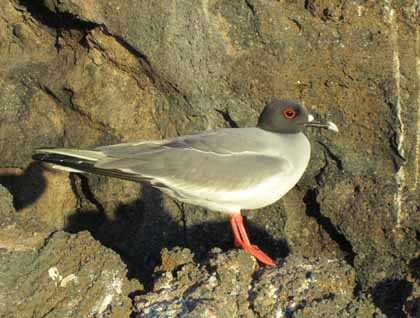Located in the northeastern-most region of the archipelago, Tower Island or Genovesa is home of over one million seabirds. The highlights here are diverse and unique, making it arguably one of the most beautiful islands in the archipelago. There are no land reptiles found her, but this island volcano is host to the smallest marine iguanas in Galapagos, as well as four species of the rarest finches, and the largest colony of red-footed boobies. The Galapagos hawk also does not travel out this far, and in the absence of this major predator, the owl has taken its place as the top predator, by adapting to hunt during the day as well as the night, making it one of the only diurnal owl species in the world.
After breakfast, we started our adventure with a walk up the famous Prince Philip’s Steps, where we were surrounded by Nazca boobies, red-footed boobies and frigatebird chicks. We were determined to find the elusive short-eared owls, but their brilliant camouflage makes them difficult to spot among the rocks. Luckily for us, we found one hiding between rocks, sheltering itself from the strong sea-breeze. Back onboard, we prepared for our last snorkeling outing of the expedition. We had close encounters with a giant manta ray, white-tipped reef sharks and many colorful fish. After this great adventure, we came back to our ship, anchored inside Genovesa caldera, to be briefed about our departure and to enjoy our last delicious lunch.
In the afternoon, we headed to the white coralline beach inside Darwin Bay, named in honor of a great naturalist who re-directed human thought, Charles Darwin. We walked over a platform at low tide, surrounded by birds of all kinds, observing their chicks, behaviors and colors. It was an incredible scene to witness, with the many adult seabirds taking care of the young, hoping that one day they will be able to fend for themselves. We were also happy to find a few marine iguanas, which are smaller and darker on Genovesa, due to the unique ecology which is so different from the islands that we’ve seen so far. The sky was full of birds, flying all over like they did in prehistoric times, and the lava formations were reminiscent of the first foundation of Earth.
Later, it was time to return to the ship and reminisce about the many experiences of this wonderful week. As we look back and gaze at the islands for the last time, this place now seems to be timeless to us. Our experience has been unforgettable and will remain deep in our hearts—memories of this special place where the wildlife has no fear, allowing us to realize that we are not so different from them. We enjoy an incredible sunset from the decks of the National Geographic Endeavour, tired but happy to remember the incredible places we visited and unique creatures that made our trip so amazing.







